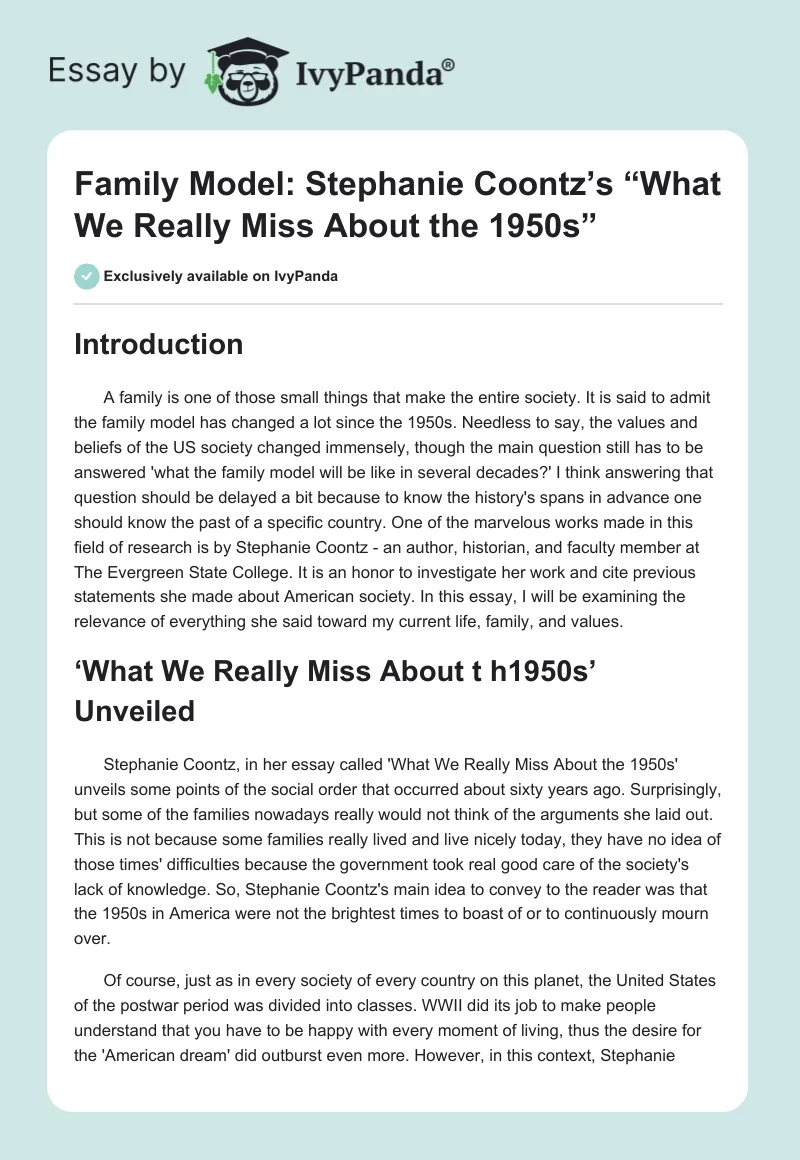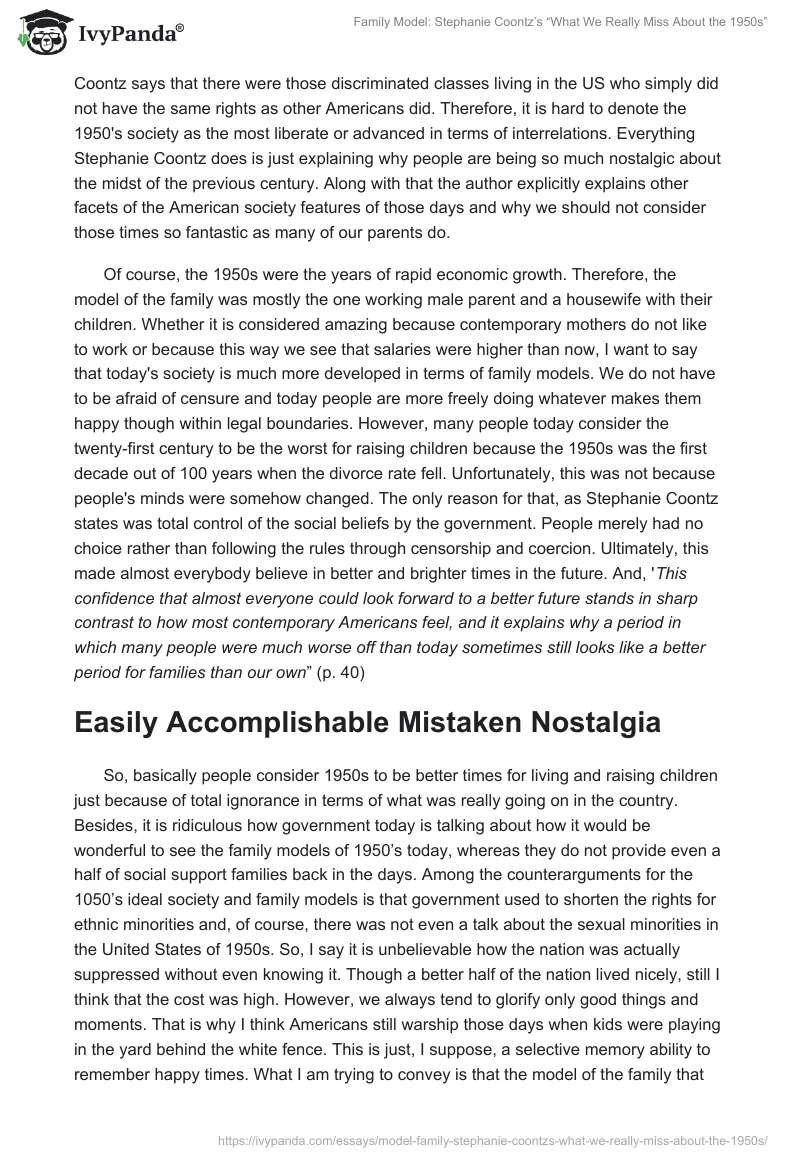Introduction
A family is one of those small things that make the entire society. It is said to admit the family model has changed a lot since the 1950s. Needless to say, the values and beliefs of the US society changed immensely, though the main question still has to be answered ‘what the family model will be like in several decades?’ I think answering that question should be delayed a bit because to know the history’s spans in advance one should know the past of a specific country.
One of the marvelous works made in this field of research is by Stephanie Coontz – an author, historian, and faculty member at The Evergreen State College. It is an honor to investigate her work and cite previous statements she made about American society. In this essay, I will be examining the relevance of everything she said toward my current life, family, and values.
‘What We Really Miss About t h1950s’ Unveiled
Stephanie Coontz, in her essay called ‘What We Really Miss About the 1950s’ unveils some points of the social order that occurred about sixty years ago. Surprisingly, but some of the families nowadays really would not think of the arguments she laid out. This is not because some families really lived and live nicely today, they have no idea of those times’ difficulties because the government took real good care of the society’s lack of knowledge. So, Stephanie Coontz’s main idea to convey to the reader was that the 1950s in America were not the brightest times to boast of or to continuously mourn over.
Of course, just as in every society of every country on this planet, the United States of the postwar period was divided into classes. WWII did its job to make people understand that you have to be happy with every moment of living, thus the desire for the ‘American dream’ did outburst even more. However, in this context, Stephanie Coontz says that there were those discriminated classes living in the US who simply did not have the same rights as other Americans did. Therefore, it is hard to denote the 1950’s society as the most liberate or advanced in terms of interrelations. Everything Stephanie Coontz does is just explaining why people are being so much nostalgic about the midst of the previous century. Along with that the author explicitly explains other facets of the American society features of those days and why we should not consider those times so fantastic as many of our parents do.
Of course, the 1950s were the years of rapid economic growth. Therefore, the model of the family was mostly the one working male parent and a housewife with their children. Whether it is considered amazing because contemporary mothers do not like to work or because this way we see that salaries were higher than now, I want to say that today’s society is much more developed in terms of family models. We do not have to be afraid of censure and today people are more freely doing whatever makes them happy though within legal boundaries. However, many people today consider the twenty-first century to be the worst for raising children because the 1950s was the first decade out of 100 years when the divorce rate fell. Unfortunately, this was not because people’s minds were somehow changed. The only reason for that, as Stephanie Coontz states was total control of the social beliefs by the government. People merely had no choice rather than following the rules through censorship and coercion. Ultimately, this made almost everybody believe in better and brighter times in the future. And, ‘This confidence that almost everyone could look forward to a better future stands in sharp contrast to how most contemporary Americans feel, and it explains why a period in which many people were much worse off than today sometimes still looks like a better period for families than our own” (p. 40)
Easily Accomplishable Mistaken Nostalgia
So, basically people consider 1950s to be better times for living and raising children just because of total ignorance in terms of what was really going on in the country. Besides, it is ridiculous how government today is talking about how it would be wonderful to see the family models of 1950’s today, whereas they do not provide even a half of social support families back in the days. Among the counterarguments for the 1050’s ideal society and family models is that government used to shorten the rights for ethnic minorities and, of course, there was not even a talk about the sexual minorities in the United States of 1950s. So, I say it is unbelievable how the nation was actually suppressed without even knowing it. Though a better half of the nation lived nicely, still I think that the cost was high. However, we always tend to glorify only good things and moments. That is why I think Americans still warship those days when kids were playing in the yard behind the white fence. This is just, I suppose, a selective memory ability to remember happy times. What I am trying to convey is that the model of the family that existed in 1950s was invented way before. Gary Colombo states: ‘what we call the ‘traditional’ family, head by a breadwinner-father and a house-wife mother, has existed for little more than two hundred years, and the suburbs only came into being in teh1950s ’ (p. 18)
Now let me provide you with some good characteristics of our age. As per Stephanie Coontz ‘a woman’s chance of getting married at older age has grown in comparison with the 1950s and 1960s’(Coontz, p. 7) whereas the women of 1950s had to ‘be fully absorbed with the youngest while simultaneously maintaining passionate sexual excitement with the husband’ (Coontz, p. 9). It seems to me that period was remarkable for hybrid ideas which were nonsense. By the way , if we peak about the historical heritage our society have held throughout ages, it has to be noticed that just like some people think of love and marriage today, very long ago ‘true love was actually thought to be incompatible with marriage’ as remarked by Stephanie Coortz in her book Marriage, a History: How Love Conquered Marriage ( p. 14).
Conclusion
Well, as such let me fully agree with the historian Stephanie Coontz and say that we cannot long for harmony or derive certain models from the past until we understand the actual meaning of everything we had in the history of the US. Thus, every young woman having kids of different ages will be happy to whatever she has when she comes back tired of work at night. I mean we cannot underestimate the historical value of the past of the United States society, though we can be completely objective to say what we really do not want to repeat. Thereby, my wish is to see a harmonious American model family no matter if it coincides with other views or the views of the government.
Works Cited
Colombo, Gary., Cullen, Robert. Rereading America: Cultural Contexts for Critical Thinking and Writing.New York: Bedford/St. Martin’s, 2010. Print.
Coontz, Stephanie. Marriage, a History: How Love Conquered Marriage. New York: Penguin (Non-Classics), 2006. Print.
Coontz, Stephanie. The Way We Never Were: American Families and the Nostalgia Trap. New York: Basic Books, 1992. Print.
Coontz, Stephanie. The Way We Really Are: Coming To Terms With America’s Changing Families.New York: Basic Books, 1998. Print.


